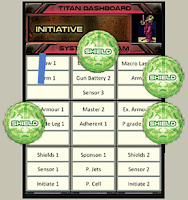Part of the design of Titanomachina is for players to be able to customize their Titans, but due to my technical limitations I've only been able to upload Titan figures as single chunks, rather than as customizable figures. I also haven't been able to fancy them up with nice paint jobs, although the ability to tint them works for board gaming purposes.
So instead I've been uploading preset configurations to try to show off how players could customize their figures if we ever got this into meatspace production. There have been three waves of configurations, each with their own customized figures, dashboards, and decks of cards.
The third wave of configurations is a set of extreme builds, or at least as extreme as one can get with minor weapon-swaps and internal equipment changes. Not too extreme. Rhea, for example, has another Reaper configuration with regular Arms and Plantigrade Legs similar to Her depiction on the box-cover art I had commissioned and that I've used as cover art for the Tabletop Simulator version of Titanomachina. In that depiction She has a Macro Gun, Rocket Pod, and a Buzz Saw. Which would maximize Her High Explosive (HE) load, but reduce Her capacity to push other Titans around. And Eos, as we will see, has two Buzz Saws! So I gave Rhea the Hand again, to emphasize Her capacity as a wrestler.


Tethys is a boxer where Rhea is a wrestler, and so in the this Reaper configuration She brings the gun show and mounts twin Plasma Howitzers on Big Arms. Backed up by a Macro Laser on the sponson mount, Tethys is going to be best suited to a knock-out where Rhea is either looking to pin Her opponent(s) down for a time-out or to hurl them off the board for a ring-out. However, extreme strength in one area is going to reveal a weakness in another. Despite Her Big Arms Tethys is not going to do well at close quarters and will want to use Her legs to maintain a healthy 5-6 square distance.


Eos is going to want to get close. They are equipped not only with two Buzz Saws, but two Mega Guns, giving Them a longest range of 3 squares. Fortunately this configuration is not only another four-armed Regent configuration, but trades in the Plantigrade Legs for Digitigrade Legs. All the better to run you down... Of course, that lack of both range and sponsons is going to be the inherent weakness of this configuration because even with six limbs Eos is going to have trouble with opponents that get behind Them.


Styxx is going to want to get closer with this Raptor configuration, trading in the sponsons and short-ranged weaponry for Big Arms and Claws. Despite this apparently inflexibility, Styxx still has two capacitors and two jump jets, along with four powerful limbs, and will be fast enough to catch opponents. Styxx's weakness is going to be like Eos' except in greater amounts because Styxx has fewer limbs and more charge-thirsty limbs and weapons. Still, once Styxx gets Her claws in you victory is not far behind.


While I would usually take this space to compare the rates of damage that each Titan can do, each of these configurations is designed to take advantage of more than the usual weapon:system:time ratios. Rhea, for example, combining HE and Hard Rounds in Her weapons array is going to wear down opponents, controlling the flow of the battle. Tethys is going to use the Shock trait of Her main guns to pin down an opponent at range where She can land a knock-out blow with Her Master Crew and Plasma Cell. Eos and Styxx are both going to be hunter-killers, looking to close and sustain an attack.
But here's some summary of the alpha-strike damage available to each:
Rhea - Weapons only 9, with limbs 15, with capacitor 18
Tethys - Weapons only 9, with limbs 17, with capacitor 20
Eos - Weapons only 12, with limbs 20
Styxx - Weapons only 6, with limbs, 16, with capacitors 22
Note: I accidentally deleted the first draft of this post. My apologies!


















































